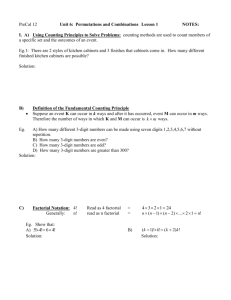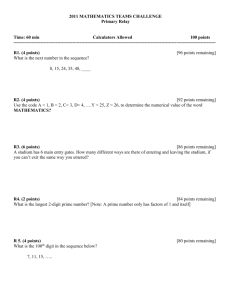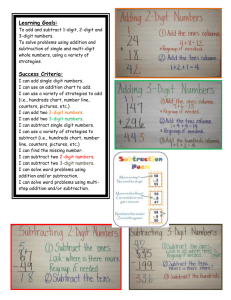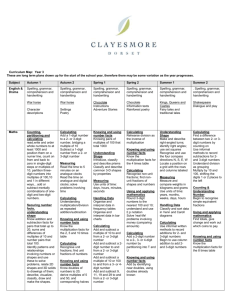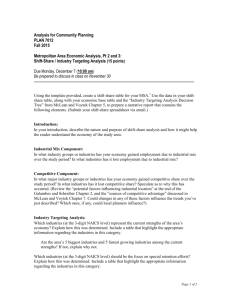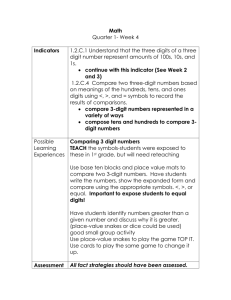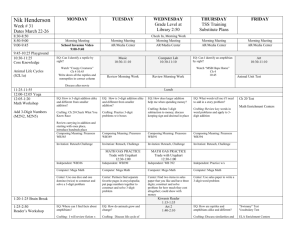Ordering 3-digit Numbers
advertisement
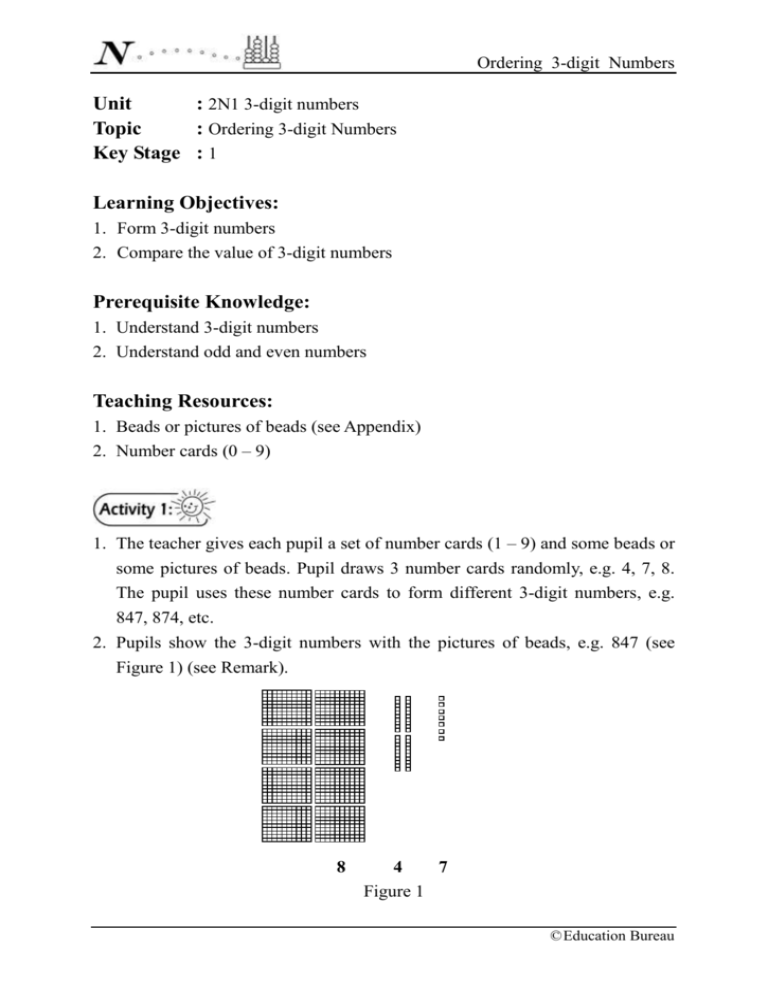
Ordering 3-digit Numbers Unit : 2N1 3-digit numbers Topic : Ordering 3-digit Numbers Key Stage : 1 Learning Objectives: 1. Form 3-digit numbers 2. Compare the value of 3-digit numbers Prerequisite Knowledge: 1. Understand 3-digit numbers 2. Understand odd and even numbers Teaching Resources: 1. Beads or pictures of beads (see Appendix) 2. Number cards (0 – 9) 1. The teacher gives each pupil a set of number cards (1 – 9) and some beads or some pictures of beads. Pupil draws 3 number cards randomly, e.g. 4, 7, 8. The pupil uses these number cards to form different 3-digit numbers, e.g. 847, 874, etc. 2. Pupils show the 3-digit numbers with the pictures of beads, e.g. 847 (see Figure 1) (see Remark). 8 4 7 Figure 1 ©Education Bureau Ordering 3-digit Numbers Questions for Discussion: 1. Which picture of beads stands for 100? 10? 1? 2. In the 3-digit number 847, which number is in the hundreds place? Tens place? Units place? What value does it stand for? How to show them with the pictures of beads? 3. What are the differences in the values when ‘8’ appears in the hundreds place, tens place or units place? 4. How many 3-digit numbers can be formed by 4, 7, 8? 5. Among all the 3-digit numbers formed, which 3-digit number is the largest? Which 3-digit number is the smallest? How do you compare the values of the two 3-digit numbers? 1. Pupils draw 3 cards from the number cards (1 – 9) and form the largest and smallest 3-digit numbers. 2. Pupils use the visualiser to show the 3-digit numbers formed by the pictures of beads. Questions for Discussion: 1. When you want to form the largest 3-digit number, how do you decide which number should be put in the hundreds place? Which number should be put in the tens place? Which number should be put in the units place? 2. When you want to form the smallest 3-digit numbers, how do you decide which number should be put in the hundreds place? Which number should be put in the tens place? Which number should be put in the units place? 1. Pupils are grouped into three. Each group is given a set of number cards (1 – 9). Each pupil is given a few sheets of pictures of beads. 2. Each pupil draws 3 cards from the set of number cards. (The cards drawn ©Education Bureau Ordering 3-digit Numbers cannot be replaced, therefore each pupil has different number cards) 3. Pupils in the group guess who can form the largest 3-digit numbers. 4. Pupils use the cards drawn to form the largest 3-digit numbers, and then present the 3-digit numbers with the pictures of beads. (see Remark) 5. Compare the three 3-digit numbers formed in the group, and find out the largest one. Questions for Discussion: 1. Before ordering the three 3-digit numbers, is there any way to decide who has formed the largest 3-digit numbers? 2. Is there any exception? 3. Which is the decisive number? Repeat Activity 3 with the number cards (1 – 9). Find the smallest 3-digit number and repeat the Questions for Discussion in Activity 3. Repeat Activity 1 and 2 with the number cards (0 – 9). Questions for Discussion: 1. Can “0” be placed in the hundreds place? Why? 2. How many 3-digit numbers can be formed by using the number cards (0 – 9)? 3. Which number is the largest? Which number is the smallest? 4. When you want to form the largest 3-digit number, how do you decide which number should be put in the hundreds place? Which number should be put in the tens place? Which number should be put in the units place? 5. If you want to form the smallest 3-digit number, how do you decide which number should be put in the hundreds place? Which number should be put in ©Education Bureau Ordering 3-digit Numbers the tens place? Which number should be put in the units place? Repeat Activity 3 and 4 with the number cards (0 – 9). Questions for Discussion: 1. Repeat Activity 3 and 4 with the number cards (1 – 9) and the number cards (0 – 9) to form the largest 3-digit number. Compare all the three 3-digit numbers formed. Is there any change in the decisive number? 2. If all three pupils in the group have not drawn the number card “9”, is there any change in the decisive number when they form the largest 3-digit number? 3. Repeat Activity 3 and 4 with the number cards (1 – 9) and the number cards (0 – 9) to form the smallest 3-digit number. Compare all the 3-digit numbers formed. Is there any change in the decisive number? (For more able pupils) Pupil draws one card of odd number and two cards of even number from the number cards (1 – 9) (e.g. 9, 8, 6) to form the largest 3-digit odd number. Questions for Discussion: Is there any difference between Activity 7 and 2 when you decide at which place should the number be placed? Remark: Pupils can use the visualiser to show the 3-digit numbers formed using the pictures of beads. ©Education Bureau Ordering 3-digit Numbers Generic Skills Fostered: Communication Skills Critical Thinking Skills Numeracy Skills Problem Solving Skills ©Education Bureau
